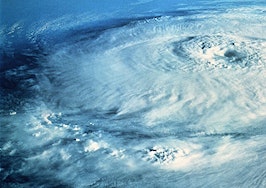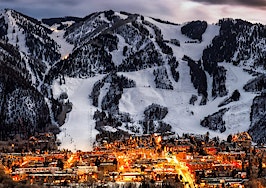Ski communities dot the U.S. and, much like their beach counterparts on the coasts, have long been among the most prized destinations for investors who want second homes. But not all ski towns are created equal, and understanding both how they differ and the objectives of a given purchase is essential to ensure the investment pays off.
For many buyers looking in winter-oriented markets, short-term rental income is a key part of the equation. And for them, a new report from vacation rental management company Vacasa suggests that the best option this year is Killington, Vermont. The report ranked ski-oriented communities based on their aggregate cap rate, or “the ratio of a property’s net operating income over its cost.” It ultimately notes that “Killington boasts a solid cap rate of 8.31 percent” — meaning investors “can feel comfortable they’ll get the most bang for their vacation rental buck.”
“Travelers flock to Killington in the winter months to take on one of six peaks boasting downhill trails to test every level of skier,” Vacasa’s report says of the town, which has fewer than 1,000 residents and is located about 150 miles northwest of Boston.
Big Sky, Montana, Breckenridge and Dillon, both in Colorado, and Ludlow, Vermont, all rounded out the top five cities that Vacasa identified as best for purchasing vacation homes.

Credit: Vacasa
Agents working in ski communities confirmed to Inman that rental income is a primary driver of purchases.
“Eighty percent want to rent them out,” Jamison Blair, an agent who leads an eponymous team at Compass in California’s Lake Tahoe basin, told Inman of his clients and their purchases.

Daimon Bushi
Daimon Bushi — a Windermere agent in Park City, Utah, who is known for doing home tours on skis — said in his market about 75 percent of buyers are looking to rent out their properties for at least part of the year. Business strategies vary; Bushi said that some owners only want to rent out properties for a few weeks, while others are looking to collect enough rent to cover a mortgage. But either way, agents in such markets need to understand how a given property might operate as a rental.
“People always like to know how it can perform as an investment,” Bushi added.
Data that Vacasa provided to Inman further illustrates where investments might perform well. The data shows that as of Nov. 26, Breckenridge had the most number of Vacasa-managed units of any ski community in the U.S. It was followed by Steamboat Springs and Vail, also both in Colorado, and Park City.
However, Vacasa actually saw the most demand through the end of November in Solitude, Utah, Big Sky, and Silverthorne, Colorado, respectively. The data further identified Eagle Crest, Oregon, Chelan, Washington, and Garden City, Utah, as “hidden gems” where bookings were low and deals could be had.
Additionally, vacation rental company Vrbo told Inman in an email that during the 2018 to 2019 ski season, Park City was its top destination. Park City also saw a 34 percent year-over-year increase in vacation rental demand.
Vrbo’s other top destinations, in descending order, included Breckenridge, Mammoth and South Lake Tahoe, both in California and Keystone, Colorado.

Downtown Park City, which has condos that lead directly out to ski slopes. Credit: Adventure_Photo and Getty Images
To be clear, the findings from both Vrbo and Vacasa have to do with bookings from travelers, not real estate sales. But they offer a useful insight into which communities are seeing high demand, and thus the places where investors are most likely to turn profits.
It’s also worth noting that when investors begin looking at ski towns for a potential second home or rental, they often aren’t as geographically constrained as buyers shopping for a primary residence.
“There’s a lot of people who cross shop Park City versus other areas,” Bushi explained, echoing comments made by other agents who told Inman their clients similarly compare ski towns from different regions and states.
So beyond rental potential, what exactly are those buyers looking for?
Most obviously, they want a good place to ski.

Drew Via
“If you have good snow, it brings buyers,” Drew Via, a Keller Williams agent in Park City, told Inman.
Beyond the snow, Via said that buyers in ski communities are looking for amenities and accessibility to recreation areas. He also said that many of his buyers are drawn to the fact that Park City, in particular, has both winter and summer activities, meaning owners can rent out properties to skiers during the snowy months but still get some use out of the units when the weather turns warm.
Given the complexities of ski town real estate, Blair urged agents to learn about local regulations and rental markets. And he advised investors to work with knowledgeable real estate professionals who can help navigate the sometimes-complex regulations governing properties that double as both rentals and owners’ homes.

Jamison Blair
“Hire somebody that’s close by who is local,” he recommended.
All the agents who spoke with Inman said that proximity to transportation infrastructure is essential. For example, everyone agreed that Park City benefits from being a half hour from Salt Lake City’s international airport — a considerably shorter distance than other more remote ski towns in other parts of the country.
The agents also all said that 2019 has been a strong period for sales. Blair, for example, said that the market in his area has slowed somewhat in the middle range, but sales have been so strong at other price points that this has turned into a record year.
“The lower end of the market and the ultra-high-end have been really good,” he explained.
Bushi made a similar point but added that historically low-interest rates and continued appreciation mean that this can still be a good time to purchase in a ski community.
“We’re still seeing a lot of confidence in the area,” he said. “I’d be lying if I said I didn’t believe its still a good time to buy.”













